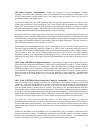24
14. PASSIVE AND ACTIVE NETWORK ANALYSIS
14.1 General – In this chapter we’ll demonstrate the ability of the HP3586 to be used for network
analysis. The HP3586 has the ability to accurately measure relative power and voltage levels over a wide
range of frequency and also output a signal at the frequency it’s tuned to. It can do the work of many
instruments in one package.
We’ll start by taking measurements on a passive band pass filter covering the 160 meter amateur radio
band, 1.8MHz to 2MHz designed to reduce strong broadcast signals near the 160 meter band. To make it
simple the filter will have a 50 ohm input and output impedance which we can easily match to a HP3586.
The second example will be a low power 50 ohm 20db gain preamplifier to cover a wide bandwidth of
14MHz to 30MHz. Finally I’ll suggest some applications using the instrument’s tracking oscillator as a
signal generator with its selective receiver as a detector for alignment of radio circuits.
As in the last chapter I’ll assume you have studied the previous chapters and are familiar with the basic
button pushing and operation of a HP3586.
14.2 Setup – Since the input and tracking oscillator output are both 75 ohms on our HP3586 I need to add
some resistors to adjust the impedance for a 50 ohm device. The output impedance of the instrument’s
tracking generator is 75 ohms, so I can connect its Fo output to the input of my device but with an added
150 ohm resistor between the circuit’s input and ground. This HP recommended method to provide the 50
ohm impedance for the device and not load the instrument’s tracking generator. If I’m using a A or B
version I add a 50 ohm load resistor to the device’s output, or the 50 ohm load shown in Appendix C,
connect it directly to the 75 ohm input of my HP3586 and turn off the internal 75 ohm termination. This
will provide the required device termination and allow me to read device’s output using the 10K 50pf input
of the unbalanced input. HP also recommends this method of input termination. If we are using a C
version we can simply use its 50 ohm terminated input and not add the external 50 ohm resistor.
Since we are going to make comparative before and after measurements we don’t have to correct the power
calculations from 75 to 50 ohms. We set our HP3586 for carrier or selective measuring mode, depending
on instrument version we’re using, and select the 20Hz filter, and automatic 10db range for maximum level
precision.
14.3 Normalizing our Level Measurements – We now disconnect the device but leave the
terminating resistors and simple connect a jumper wire between the terminating resistors to simulate a zero
loss device. We now can read the output of our instrument’s oscillator signal through the short circuit,
which should be a little less than 0dbm since the oscillator’s output is 0dbm. Say the display reads –
1.11dbm due to termination and other losses. We now can easily normalize out future level reading to the
zero loss level using the same method of the previous chapter of putting the displayed dbm level into the
offset register and turning on the offset function. Press [RDNG→OFFSET] on the entry panel followed by
pressing [OFFSET] on the measurement/entry panel to store the displayed reading in the offset register and
turn on the offset function.
14.4 Measuring the Filter’s Pass Band and Loss – We now reinstall the filter and start to take
measurements. At a frequency of 1900KHz in the center of the filter’s pass band, say our display now
reading is –2.42db. As we tune the instrument’s frequency between 1820KHz and 1970KHz it stays close
to this value. By recording relative levels vs. frequency we can plot the filters frequency response along
with its insertion loss in db relative to it’s input power.
14.5 Measuring an Amplifier’s Gain and Frequency Response – We can now use a similar
procedure to find the gain of our wide band amplifier. However, we had normalized our level display for
near a 0 dbm standard, but since we think our amplifier should have a +20db gain we will be inputting
power levels close to the maximum measuring capability or our HP3586. We should reduce the input


















